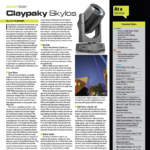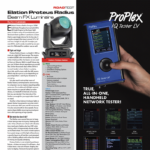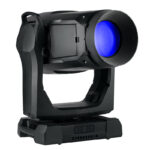Martin Professional has been a leading manufacturer of moving lights for many years, and their MAC series of lights has been incredibly successful. With the MAC Quantum Profile, the company moves into previously unexplored territory, combining the fast-growing area of LED technology with their optics and color systems, and the result is the company’s latest LED profile light.
Dimming
A few years ago, I would not have predicted that hard-edged LED movers would take the subtractive mixing path that they have — I would have expected RGB (with white and/or amber) systems to be the norm. Phosphor-converted white LEDs are very efficient, though I wonder what the performance tradeoffs would be for using an RGBAW system. Regardless, manufacturers have mostly committed to subtractive systems for hard-edged lights, and the Quantum Profile is no different. It uses a user-replaceable array of 90 white LEDs mounted on a flat surface, above which is mounted a series of honeycomb-like plastic lenses (molded as one piece into a slightly concave shape) to bring the beam from the LED dies into a usable angle. There is no mechanical dimmer; the dimming is completely electronic. It is also extremely smooth, with no noticeable aberrations or jumps, even in the last few clicks before blackout. The quality of this system is excellent; this is an extremely usable dimmer. The default mode is a square law curve, which matches an ideal curve almost exactly, though if you like, you can select linear, inverse square, or S-curve laws.
Martin markets this as a direct replacement for a 700-watt discharge light, and in terms of output, there’s no question that it meets that goal. It’s very nearly identical in output to Martin’s MAC 700 Profile, and with a native 6500 Kelvin color temperature, has an extremely even, beautiful field free of hotspots.
That LED array is also how Martin accomplishes a trick unique to this light, which they call Animotion. This “breaks up” the array into sections, which the user can control with two effects channels. The effect is not quite an animation wheel, it changes the apparent parallax of the source with regard to the optical system. Think moving a flashlight behind a stationary object and watching the shadow move on a wall. Gobos appear to “shift” position slightly, an interesting and unique effect. Along with Animotion effects, the Quantum Profile has well over 100 pre-programmed effects, and two channels on which they are all available, allowing the user to overlay the macros as desired. Included are zoom, prism, gobo, dimmer, strobe, and color along with the Animotion effects. A variety of strobes are all included — slow, fast, random, pulses, bursts, etc.
Color
Immediately after the LED array comes the dichroic color mixing flags. These represent a slight departure from earlier Martin products, which used a flag system on tracks. Here, relatively large flags with a very finely-etched pattern move into and out of the beam, each with their own individual motor. The quality of the mixing is very good, with no unevenness of the beam noticeable at medium and wide zoom ranges, and the entire system moves very smoothly. The beam becomes somewhat unevenly-colored at the extreme narrow end of the zoom range, as does the projected circle of light. Speed and precision are excellent — one of the advantages of this system. Very fast and snappy color bumps should be very effective with this light. The weakest color is red — white LEDs begin as blue LEDs, which are then treated with a phosphor to give white light, and lack red energy in their spectrum.

The fixed color wheel comes immediately after the color mixing module, and has six pie wedge-shaped filters arranged around it. These fill in gaps in the mix system quite nicely, and include a CTO filter that brings the output of the light down to a pleasing 3200 Kelvin color temperature. The colors are very close together on the wheel, which results in very usable half-colors. Again, speed and smoothness of the fixed wheel are excellent — changes happened almost instantaneously.
Gobos
Martin has included six rotating replaceable gobos on a carriage system and ten non-replaceable static gobos on a stamped metal wheel. Movement speed on both the rotating gobos and the fixed wheels is good, and there’s a good selection of patterns for aerials, projection, and animation effects. All of these gobos are subject to some spherical distortion in which the center and the edges of the gobo cannot be in perfect focus at the same time, which is particularly noticeable on the fixed wheel. This is a consequence of the way the LED lenses take the large diameter of the light source and condense it — you have to reduce that large source down to something more manageable. However, I do not expect that it would be objectionable for the light’s intended users.
Last in line on the main module is an iris, capable of extremely fast speeds. All these — color mixing, gobos, and iris — are located in a single module that removes with no tools. Instead, there are two spring-loaded retaining clips that you pull back on, and the whole module slides out, making service and cleaning especially painless.
Focus and Prism
The unit includes a three-facet prism on the familiar swing-arm mechanism. Insertion is quite snappy — fast enough to use as an effect, which I really like — and the prism provides good image separation as well as possessing a good range of rotation speeds. One point of note here is that the prism exaggerates any uneven coloration in the beam with half-mixed colors like lavender or orange, something to be aware of when programming.
The 3:1 zoom covers its entire 12° to 36° range in less than a second, and Martin provides three levels of focus tracking. These worked reasonably well, keeping the focus consistent across the zoom range when set correctly, although it was slightly more successful on the rotating wheel than the fixed one.
Movement and Construction
Pan and tilt move quite fast for a unit of this size, and are somewhat loud, though increasing the crossfade times helps a lot with this. I timed the pan going full speed at 2.3 seconds for a full rotation, and tilt at 1.1 seconds. These are respectable figures considering the unit’s size and weight — average travel distances are likely to be smaller.
Homing from a cold start to final look output takes 36 seconds, and resetting while outputting is done well, with the light fading down to black, resetting, finding its position, and then fading back up into its look. I really appreciate that kind of thoughtfulness for those (hopefully) rare times when I need to reset a light during a show.
Power auto-ranges from 120V to 240V, and input is via a Neutrik PowerCON connection, with 5-pin DMX in and through on the back panel, and the menu on the other side. Martin has continued having a battery for the menu system so that fixture modes and addresses can be set without powering the light — a nice touch. Another great innovation here is a USB port on the front for software updates — no more hunting for a USB to DMX box or a proprietary loading device.
At a Glance
No Compromises Required
The MAC Quantum Profile has a feature set and brightness to easily rival its conventional 700-watt arc lamp brethren. As an LD, I appreciate that the quirks of LEDs are almost entirely absent with this light — I can simply design, and let the unit take care of the rest. —C.R.
PROS: Extremely bright, smooth and fast color mixing, fast effects
CONS: None
SPECS
- Size 17.8 x 17 x 23.5 inches (LxWxH)
- Weight 23.2 kg (51.1 lbs.)
- Manufacturer: Martin Professional
- More Info: www.martin.com
MORE SPECS
- Color Mixing: CMY
- Power Supply: AC Power:120-240 V nominal, 50/60 Hz
- Power Usage: 750W max; typical half-cycle RMS inrush current: 10.3A
- Color Wheel: 6 color filters plus open
- Rotating Gobo Wheel: 6 interchangeable gobos plus open, wheel rotation, gobo rotation, indexing and shake
- Static Gobo Wheel: 10 gobos plus open, wheel indexing, rotation and shake
- Beam Effects: Rotating three-facet prism
- Zoom: 12° – 36° (1:3)
- Focus: Motorized, with zoom-focus tracking
- Iris: 0 – 100%, pulse effects
- Shutter Effect: Electronic, with variable speed regular and random strobe
- Electronic Dimming: Four dimming curve options
- Pan: 540°
- Tilt: 268°



